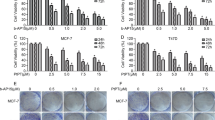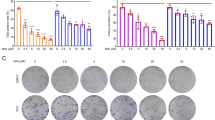Abstract
Purpose
To investigate apigenin (5,7,4-trihydroxyflavone), a dietary flavonoid with proteasome-inhibitory activity (desired for the management of multiple types of cancers), against FDA-approved anticancer proteasome inhibitor bortezomib in context to its effects on the tumor suppressor estrogen receptor-beta (ER-β) in prostate cancer cells.
Methods
Prostate cancer (PC-3) cells were treated with either apigenin or bortezomib, and proliferation inhibition was correlated with proteasomal biochemistry, ER-degradation and cell apoptosis.
Results
Apigenin specifically inhibited only chymotrypsin-like activity of proteasome without affecting trypsin and caspase-like activities, which was in contrast to the non-specific inhibition of all the three activities by bortezomib. Apigenin selectively increased the protein levels of ER-β at 1.8 and 10.0 µM (without affecting mRNA levels) and preferentially accumulated ubiquitinated ER-β over ER-α in PC-3. Apigenin-treated cells exhibited increased ER-β interactions with ubiquitin-protein ligase E6AP, downregulated PSMA5 (α-5 subunit for assembly of 20S proteasome) without affecting PSMB1 (β-1 subunit), PSMB2 (β-2 subunit) and PSMB5 (β-5 subunit, whose overexpression by bortezomib causes drug resistance) of proteasome at mRNA levels. Caspase-3 activation in PC-3 by apigenin was dependent on caspase-8 activity but independent of mitochondrial membrane depolarization. The deubiquitinase USP14 activity, which antagonizes degradation of proteins via proteasome, was significantly increased by apigenin treatment.
Conclusions
Apigenin selectively inhibits proteasomal degradation of tumor suppressor ER-β by specifically inhibiting chymotrypsin-like activity of proteasome, preventing its assembly via PSMA5 and inhibiting USP14 enzyme activity in prostate cancer cells, resulting in cancer cell apoptosis. Unlike bortezomib, apigenin’s actions are subtle, precise, mechanistically distinct and capable of abstaining drug resistance.









Similar content being viewed by others
References
Globocan (2008) Cancer incidence and mortality worldwide. http://www.iarc.fr/en/media-centre/iarcnews/2010/globocan2008.php. Accessed 16 Nov 2014
Papandreou CN, Logothetis CJ (2004) Bortezomib as a potential treatment for prostate cancer. Cancer Res 64:5036–5043
Chen L, Madura K (2005) Increased proteasome activity, ubiquitin-conjugating enzymes, and eEF1A translation factor detected in breast cancer tissue. Cancer Res 65:5599–5606
Voutsadakis IA, Papandreou CN (2012) The ubiquitin–proteasome system in prostate cancer and its transition to castration resistance. Urol Oncol 30:752–761
Zhang L, Littlejohn JE, Cui Y, Cao X, Peddaboina C, Smythe WR (2010) Characterization of bortezomib-adapted I-45 mesothelioma cells. Mol Cancer 9:110
Lee DH, Goldberg AL (1998) Proteasome inhibitors: valuable new tools for cell biologists. Trends Cell Biol 8:397–403
Poulaki V, Mitsiades CS, Kotoula V, Negri J, McMillin D, Miller JW, Mitsiades N (2007) The proteasome inhibitor bortezomib induces apoptosis in human retinoblastoma cell lines in vitro. Invest Ophthalmol Vis Sci 48:4706–4719
Kane RC, Farrell AT, Sridhara R, Pazdur R (2006) United States food and drug administration approval summary: bortezomib for the treatment of progressive multiple myeloma after one prior therapy. Clin Cancer Res 12:2955–2960
Parlati F, Lee SJ, Aujay M, Suzuki E, Levitsky K, Lorens JB, Micklem DR, Ruurs P, Sylvain C, Lu Y, Shenk KD, Bennett MK (2009) Carfilzomib can induce tumor cell death through selective inhibition of the chymotrypsin-like activity of the proteasome. Blood 114:3439–3447
Neilsen PM, Pehere AD, Pishas KI, Callen DF, Abell AD (2013) New 26S proteasome inhibitors with high selectivity for chymotrypsin-like activity and p53-dependent cytotoxicity. ACS Chem Biol 8:353–359
Lu S, Chen Z, Yang J, Chen L, Gong S, Zhou H, Guo L, Wang J (2008) Overexpression of the PSMB5 gene contributes to bortezomib resistance in T-lymphoblastic lymphoma/leukemia cells derived from Jurkat line. Exp Hematol 36:1278–1284
Chen D, Daniel KG, Chen MS, Kuhn DJ, Landis-Piwowar KR, Dou QP (2005) Dietary flavonoids as proteasome inhibitors and apoptosis inducers in human leukemia cells. Biochem Pharmacol 69:1421–1432
Way TD, Kao MC, Lin JK (2004) Apigenin induces apoptosis through proteasomal degradation of HER2/neu in HER2/neu-overexpressing breast cancer cells via the phosphatidylinositol 3-kinase/Akt-dependent pathway. J Biol Chem 279:4479–4489
He J, Xu Q, Wang M, Li C, Qian X, Shi Z, Liu LZ, Jiang BH (2012) Oral administration of apigenin inhibits metastasis through AKT/P70S6K1/MMP-9 Pathway in orthotopic ovarian tumor model. Int J Mol Sci 13:7271–7282
Horvath LG, Henshall SM, Lee CS, Head DR, Quinn DI, Makela S, Delprado W, Golovsky D, Brenner PC, O’Neill G, Kooner R, Stricker PD, Grygiel JJ, Gustafsson JA, Sutherland RL (2001) Frequent loss of estrogen receptor-beta expression in prostate cancer. Cancer Res 61:5331–5335
Ellem SJ, Risbridger GP (2009) The dual, opposing roles of estrogen in the prostate. Ann NY Acad Sci 1155:174–186
Li B, Hu Q, Xu R, Ren H, Fei E, Chen D, Wang G (2012) Hax-1 is rapidly degraded by the proteasome dependent on its PEST sequence. BMC Cell Biol 13:20
Harlow E, Lane D (2006) Bradford assay. CSH Protoc. doi:10.1101/pdb.prot4644
Harrington HA, Ho KL, Ghosh S, Tung KC (2008) Construction and analysis of a modular model of caspase activation in apoptosis. Theor Biol Med Model 5:26
Kisselev AF, Garcia-Calvo M, Overkleeft HS, Peterson E, Pennington MW, Ploegh HL, Thornberry NA, Goldberg AL (2003) The caspase-like sites of proteasomes, their substrate specificity, new inhibitors and substrates, and allosteric interactions with the trypsin-like sites. J Biol Chem 278:35869–35877
Meng L, Mohan R, Kwok BH, Elofsson M, Sin N, Crews CM (1999) Epoxomicin, a potent and selective proteasome inhibitor, exhibits in vivo antiinflammatory activity. Proc Natl Acad Sci USA 96:10403–10408
Dey P, Strom A, Gustafsson JA (2014) Estrogen receptor beta upregulates FOXO3a and causes induction of apoptosis through PUMA in prostate cancer. Oncogene 33:4213–4225
Lau KM, LaSpina M, Long J, Ho SM (2000) Expression of estrogen receptor (ER)-alpha and ER-beta in normal and malignant prostatic epithelial cells: regulation by methylation and involvement in growth regulation. Cancer Res 60:3175–3182
Picard N, Charbonneau C, Sanchez M, Licznar A, Busson M, Lazennec G, Tremblay A (2008) Phosphorylation of activation function-1 regulates proteasome-dependent nuclear mobility and E6-associated protein ubiquitin ligase recruitment to the estrogen receptor beta. Mol Endocrinol 22:317–330
Berry NB, Fan M, Nephew KP (2008) Estrogen receptor-alpha hinge-region lysines 302 and 303 regulate receptor degradation by the proteasome. Mol Endocrinol 22:1535–1551
Eakin CM, Maccoss MJ, Finney GL, Klevit RE (2007) Estrogen receptor alpha is a putative substrate for the BRCA1 ubiquitin ligase. Proc Natl Acad Sci USA 104:5794–5799
Stanisic V, Malovannaya A, Qin J, Lonard DM, O’Malley BW (2009) OTU Domain-containing ubiquitin aldehyde-binding protein 1 (OTUB1) deubiquitinates estrogen receptor (ER) alpha and affects ER alpha transcriptional activity. J Biol Chem 284:16135–16145
Tateishi Y, Sonoo R, Sekiya Y, Sunahara N, Kawano M, Wayama M, Hirota R, Kawabe Y, Murayama A, Kato S, Kimura K, Yanagisawa J (2006) Turning off estrogen receptor beta-mediated transcription requires estrogen-dependent receptor proteolysis. Mol Cell Biol 26:7966–7976
Matthews J, Gustafsson JA (2003) Estrogen signaling: a subtle balance between ER alpha and ER beta. Mol Interv 3:281–292
Le Romancer M, Poulard C, Cohen P, Sentis S, Renoir JM, Corbo L (2011) Cracking the estrogen receptor’s posttranslational code in breast tumors. Endocr Rev 32:597–622
Hirano Y, Hendil KB, Yashiroda H, Iemura S, Nagane R, Hioki Y et al (2005) A heterodimeric complex that promotes the assembly of mammalian 20S proteasomes. Nature 437:1381–1385
Arlt A, Bauer I, Schafmayer C, Tepel J, Muerkoster SS, Brosch M, Roder C, Kalthoff H, Hampe J, Moyer MP, Folsch UR, Schafer H (2009) Increased proteasome subunit protein expression and proteasome activity in colon cancer relate to an enhanced activation of nuclear factor E2-related factor 2 (Nrf2). Oncogene 28:3983–3996
Sacco JJ, Coulson JM, Clague MJ, Urbe S (2010) Emerging roles of deubiquitinases in cancer-associated pathways. IUBMB Life 62:140–157
Song L, Rape M (2008) Reverse the curse—the role of deubiquitination in cell cycle control. Curr Opin Cell Biol 20:156–163
D’Arcy P, Linder S (2012) Proteasome deubiquitinases as novel targets for cancer therapy. Int J Biochem Cell Biol 44:1729–1738
Lee MJ, Lee BH, Hanna J, King RW, Finley D (2011) Trimming of ubiquitin chains by proteasome-associated deubiquitinating enzymes. Mol Cell Proteomics 10:R110 003871
Kumar R, Verma V, Jain A, Jain RK, Maikhuri JP, Gupta G (2011) Synergistic chemoprotective mechanisms of dietary phytoestrogens in a select combination against prostate cancer. J Nutr Biochem 22:723–731
Acknowledgments
This study was supported by a grant from the Ministry of Health and Family Welfare, Government of India (GAP0001). [CDRI communication number 8844]
Conflict of interest
None.
Author information
Authors and Affiliations
Corresponding author
Electronic supplementary material
Below is the link to the electronic supplementary material.
Rights and permissions
About this article
Cite this article
Singh, V., Sharma, V., Verma, V. et al. Apigenin manipulates the ubiquitin–proteasome system to rescue estrogen receptor-β from degradation and induce apoptosis in prostate cancer cells. Eur J Nutr 54, 1255–1267 (2015). https://doi.org/10.1007/s00394-014-0803-z
Received:
Accepted:
Published:
Issue Date:
DOI: https://doi.org/10.1007/s00394-014-0803-z




